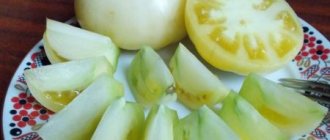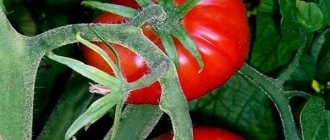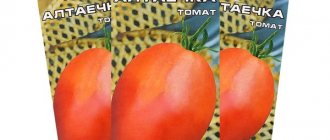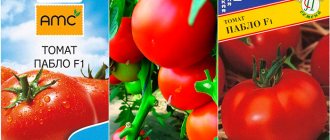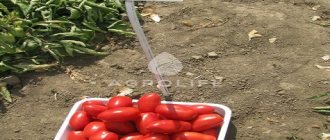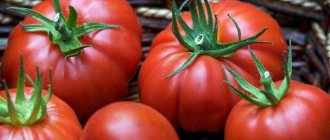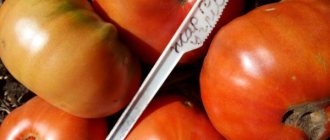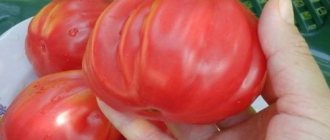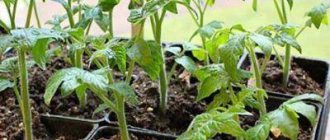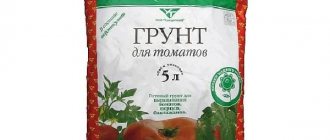Kibiz is actively cultivated in various climatic conditions and shows good fruit set in rainy and excessively hot seasons. Valued for productivity, excellent marketability and transportability.
| Height | Landing location | Ripening time | Fruit color | Fruit size | Origin | Fruit shape |
| Medium height | Greenhouse, Open ground | Early ripening | Reds | Average | Variety | Pepper-shaped |
Description of Kibitz tomatoes
The history of the creation of the Kibitz tomato is unknown, since reliable data about it does not exist. Seed material enters Russia mainly from Ukraine, so there is a version that this species was bred there or in neighboring Poland.
In view of this, Kibits is not included in the State Register, and it is impossible to find it in the assortment of domestic seed companies.
The Kibitz tomato has limited bush growth, as it is one of the determinate species. The maximum plant height is 60-70 cm in open ground, and 80-100 cm in a greenhouse or greenhouse. The bush is spreading, with 3-4 main shoots. The plant should be shaped. It needs additional support, since when numerous tomatoes ripen, the stems bend toward the ground under load, which can negatively affect the presentation.
Important! The Kibitz tomato can be grown in greenhouses, greenhouses, and open ground.
The leaves of this species have a standard shape, medium size, and a dark green hue. The first flower brush is formed above the 4-5th leaf, and each subsequent one is formed after three. They grow 5-7 tomatoes. The peduncle is articulated.
Tomato Kibits is a mid-early variety. Tomato ripening occurs 100-110 days after germination.
Errors during cultivation
Caring for tomatoes is not a difficult task, but many people make a number of mistakes. The most common ones are:
- poor-quality preparation of seed and soil;
- violation of the rules of agricultural technology when transplanting seedlings;
- irrational watering of beds;
- untimely application of fertilizers.
One common mistake is watering young plants too much. Tomato is a moderately moisture-loving crop. Each young plant does not require more than 2-3 liters per watering. Abundant watering washes nitrogen from the upper layers of the soil into the depths, as a result of which it becomes unavailable to plant roots. Probably many people themselves have noticed that those plants that are watered abundantly have a pale green color - this is an indicator of a lack of nitrogen. And tomato plants with moderate watering are distinguished by a dark green color of stems and leaves.
Description of fruits
Kibitz tomatoes have an elongated oval shape. They are all about the same size. The weight of tomatoes is 60-70 g. Initially, tomatoes have a light green tint with a large dark spot in the area of the stalk. When ripe they acquire a uniform red color. The pulp is fleshy, sweet, with slight sourness. Inside there are small seed chambers - 2 pieces each. in every tomato. The fruits have a rich tomato aroma.
When fully ripe, the fruits begin to fall off, so harvesting must be done in a timely manner. Kibitz tomatoes have dense, thin skin and medium-consistency pulp. These qualities contribute to long-term storage of the crop and also allow it to be transported without loss of presentation.
Important! As they grow, Kibitz tomatoes are blunt-nosed, but when ripe they develop a sharp tip.
Tomato has a stable yield
Description of the tomato variety Lazy Miracle
An early-ripening, high-yielding crop is distinguished by the following characteristics:
- bush type compact, determinate, with limited growth, medium bushy;
- bush height from 45 to 50 cm;
- stems are compact, powerful, straight, slightly leafy;
- leaves are medium-sized, moderately patterned, lanceolate;
- the color of the leaves and stems is dark green;
- flower clusters are abundant, located on the side shoots;
- the number of fruits per bunch is from 6 to 8 pcs.
The first inflorescence is formed at the level of 6-7 leaves, each subsequent one - after 2-3 leaves
The first inflorescence is formed at the level of 6-7 leaves, each subsequent one - after 2-3 leaves
Description of fruits
Tomato bushes of this variety are an impressive sight: massive clusters produce numerous, dense fruits of regular shape. Tomatoes are characterized by an ideal presentation and the following characteristics:
- fruit shape: plum-shaped, slightly elongated, with an elongated tip;
- average fruit weight up to 60 g;
- fruit color is even, deep red;
- the pulp is dense, with small seed chambers;
- the skin is dense, not prone to cracking;
- the taste of the pulp is balanced tomato, with a characteristic sweet note;
- dry matter content - up to 6%;
- sugar content - up to 4.5%.
An amazing feature is the almost identical shape, weight and size of all the tomatoes on one bunch.
Characteristics of the Kibitz tomato
Every gardener wants to get the maximum yield when growing a particular variety. Therefore, in order to understand what results can be expected when cultivating the Kibitz tomato, you need to study its main characteristics.
Kibitz tomato yield and fruiting
Kibitz tomatoes ripen in late July - early August, depending on the growing region. The yield per plant in open and closed ground is 3.5 kg, which means that from 1 sq. m you can harvest up to 14 kg of tomatoes. This variety easily tolerates dense plantings. At the same time, its productivity does not decrease.
But the ovary of this species does not depend on weather conditions. And even with significant cooling, the plant does not shed its flowers.
Important! Kibitz tomatoes are not prone to cracking even in high humidity conditions.
Area of application of fruits
The Kibits variety is universal. Tomatoes can be eaten fresh or processed. Due to their small size, they can be used for whole-fruit canning, pickling and pickling. Kibitz tomatoes are also suitable for salads where sliced pieces are needed. During the cooking process, the pulp retains its structure and taste.
Kibits tomatoes can be dried and dried, and also used for juice, paste, sauce, lecho.
Resistance to diseases and pests
Tomato Kibitz shows increased resistance to common crop diseases. But in rainy, cool summers it may suffer from late blight. Therefore, for preventive purposes, bushes should be sprayed with fungicides to preserve the harvest.
This species can also suffer from the Colorado potato beetle when planting seedlings in open ground and from whitefly in a greenhouse. Therefore, when the first signs of damage appear, it is necessary to take protective measures.
Reviews from gardeners
Reviews from vegetable growers about the Kibitz tomato variety are different: some like this early, high-yielding plant, others were dissatisfied with the taste of the fruit. These tomatoes are great for home canning.
Those who grew this variety note that the crop does not like sandy soil, and is also quite demanding in terms of timely application of fertilizers. The advantage of the vegetable is the fact that it can be grown both in open areas and in greenhouses. Vegetable growers did not see a significant difference in yield indicators.
An important drawback of tomatoes, according to some gardeners, is poor attachment of the fruit to the branches. They often involuntarily crumble to the ground even before the harvest period, so sometimes cardboard or paper is laid between the bushes.
The Kibitz tomato variety is an excellent option for beginning gardeners. Thanks to the competent recommendations given by professionals, each of them will have the opportunity to get a wonderful harvest.
Advantages and disadvantages of the variety
The Kibitz tomato, like other types, has certain pros and cons. And in order to appreciate this variety, you need to study them in advance.
In some catalogs the tomato can be found under the name Chibis
pros
- friendly ripening of fruits;
- versatility of use;
- early maturation;
- low maintenance;
- stable yield;
- suitability for long-term storage and transportation;
- excellent presentation;
- increased resistance to diseases;
- does not suffer from changes in temperature or humidity.
Minuses
- inferior in taste to salad varieties;
- When ripe, the fruits fall off.
Diseases and pests
The “Kibits” variety has increased resistance to blossom end and root rot and is tolerant to late blight. If agricultural practices are followed, the plant rarely gets sick.
If, nevertheless, a tomato is affected by pests - nematodes, spider mites or caterpillars - first of all it is necessary to remove the diseased plant, dig up the soil on the rest of the plantation and use infusions of onion and garlic peels to spray the bushes (soak 200 g per 1 liter of water). By the way, this mixture can also be added when planting seedlings.
The Kibitz tomato variety is quite suitable for fresh consumption; its fruits are very tasty and healthy. But it is especially good in whole-fruit canning. Can be used in any type of workpiece.
Features of cultivation
It is necessary to grow the Kibitz tomato in seedlings. By the time the seedlings are transplanted to a permanent place, their age should be 55-60 days. Therefore, sowing should be done in early or mid-March.
For planting, you need to prepare a nutritious soil mixture of turf, sand, humus and leaf soil in a ratio of 2:1:1:1. Disinfection should also be carried out. To do this, soak the seeds in a weak solution of potassium permanganate for 15 minutes. Then rinse with clean water and dry until fluffy.
The substrate also needs to be disinfected. To do this, it should be poured with the same solution of potassium permanganate and dried. When planting, you should use wide containers with a height of 10-12 cm, with holes for removing excess moisture. They should be filled with soil, watered, and the surface leveled. Place the seeds at a distance of 2 cm from each other, sprinkle with a layer of soil - 0.5 cm, moisten with a spray bottle.
After planting, the containers should be covered with film and then placed in a dark place with a temperature of +24-+25 degrees. When sprouts appear, the containers should be moved to the windowsill and the maintenance mode should be lowered to +20 degrees. When two true leaves appear, plant the plants in separate cups, and after two weeks feed them with mineral fertilizer for seedlings.
You can plant seedlings in a permanent place in a greenhouse in early May, if the ground has warmed up to +15-+18 degrees, and in open ground - at the end of this month or early June. For 1 sq. m need to place six plants.
Important! When transplanting to a permanent place, the seedlings should be buried down to the first pair of leaves, which promotes the development of a powerful root system.
Watering Kibitz tomatoes should be done as the top layer of soil dries. To do this, it is better to use settled water at a temperature of +18 degrees. Also, caring for the variety involves regular fertilizing. For the first time, you should use mullein 1:10 or chicken manure 1:15 while growing green mass. Then you need to switch to mineral fertilizers: superphosphate (40 g) and potassium sulfide (30 g) per bucket of water. They need to be applied during flowering and fruit formation.
In hot summer conditions, the soil at the base of the bushes should be mulched with peat or humus to reduce moisture evaporation.
Care
Determinate Kibitz tomato bushes do not require pinching or shaping. If during the fruiting period there is a threat of damage to the stems or shoots of the plant, the crop must be fixed on a support.
Seedlings need a lot of light
Watering tomatoes is done as the soil dries, preventing the formation of a hard crust on the top layer of soil. Excess moisture is just as dangerous for a crop as its deficiency, and can cause rotting of the plant’s root system.
For irrigation, warm, settled water is used, which is recommended to be applied by drip in the early morning or evening, after sunset.
During the entire growing season, it is advisable to apply the following fertilizers to Kibitz tomatoes:
- 10-14 days after planting the seedlings on the bed - liquid organic and nitrogenous substances;
- during the period of flowering and formation of ovaries - nitrogen, potassium and phosphorus-containing agents;
- in the fruiting phase - phosphorus-potassium fertilizing.
The soil between the bushes must be loosened regularly to get rid of weeds. This will retain more nutrients in the soil and also improve air circulation in the root zone of the plant.
Pest and disease control
Despite the increased resistance of the Kibitz tomato to diseases, it is necessary to apply preventive treatment of bushes against late blight. It should be started two weeks after transplantation to a permanent place, and repeated every 14 days.
The following fungicides should be used for treatment:
- "Ridomil Gold";
- "Quadris"";
- "Hom."
Important! When repeating treatments, the drugs must be alternated.
To protect against the Colorado potato beetle and whitefly, Kibitz tomatoes should be sprayed with Confidor Extra working solution before planting in open ground. And repeat processing if necessary.
Tomato Chibis - a stable harvest without much hassle
What tomatoes could be named after the perky lapwing bird? Of course, they are short, with medium-sized fruits and unpretentious to grow. The shape of the fruits of this variety is elongated, pepper-shaped with a sharp beak-like nose. Small and dense tomatoes are great for canning, barrel pickling and cooking in their own juice.
History of growing Chibis tomato
Gardeners have been familiar with Chibis tomatoes for more than ten years. The variety was registered in the State Register in 2007 with permission for cultivation in all regions of the country. The application for state variety testing was submitted jointly by V.I. Kozak, Candidate of Agricultural Sciences, and Moscow Agro, which specializes in the sale of proprietary seeds.
Lapwing has gained fame as one of the best tomatoes for whole-fruit canning. It attracts not only its fruits that are ideal for pickling, but also its simple agricultural technology. Bushes can be grown without pinching or staking, without fear of fungal diseases.
Chibis tomatoes bear fruit well without staking or pinching
On forums, some gardeners compare Chibis with the Kibits tomato, which is common in Ukraine. Indeed, the varieties are similar, but there are also differences, for example, Kibits is earlier, non-seedling, and its bush is more compact.
Tomatoes Kibits and Chibis are similar, but still differ in some characteristics
Description of the variety and photo of the fruits
Chibis seeds are available for free sale under the brands “Gavrish”, “Sedek”, “Aelita”. These manufacturers give the tomato the following description:
- According to the ripening period, it is mid-season and mid-early; 100–110 days pass from the emergence of seedlings to the ripening of the first fruits.
- The bush is low, with limited growth, 50–60 cm in height.
- The fruits are elongated, cylindrical, with a spout, bright red, weighing 50–70 g. The tomatoes are very dense, do not crack, contain a lot of dry matter, and have a rich tomato taste.
A characteristic feature of the Lapwing is the sharp nose at the top of the fruit.
The yield declared by “Gavrish” is 3 kg per bush, but for this the fruits must be collected in the wild and ripened at home.
Characteristics of the Chibis tomato from the State Register of Breeding Achievements (table)
| Place of cultivation | open ground and under film covers on private farms |
| Purpose | salad and for whole-fruit canning |
| According to ripening period | mid-early |
| Bush | determinant |
| Sheet | green, medium size |
| Inflorescence | simple |
| peduncle | with articulation |
| Fetus | cylindrical, slightly ribbed, dense, red when fully ripe |
| Number of seed chambers | 2–3 |
| Weight of one fruit | 50–55 g |
| Taste | good |
| Productivity | 2.1 kg/m2 |
| Immunity | to crown and root rot |
Features of cultivation
Sow Lapwing tomato seeds in the last ten days of March, the deadline is early April. During the seedling period, care is standard: picking, watering, fertilizing and hardening before planting in a permanent place. Plant seedlings in open ground at the time when all return frosts have passed, and in a greenhouse and under temporary shelter - 1-2 weeks earlier.
Video: details about caring for tomato seedlings
The layout of Lapwing tomatoes in the garden is 40x60 cm. Care consists of abundant watering once a week in the absence of rain, loosening and fertilizing every 10–14 days with complex mixtures for tomatoes. The bushes do not need to be tied up or pinched. Chibis tomatoes have dense skin and, even lying on the ground, are not damaged by rot. With such minimal care there will be a lot of fruits, but small ones - about 50 g.
If you have time for formation and garter, then you can grow tomatoes almost 1.5 times larger - 70 g each. Remove all the stepsons below the first cluster, do not touch the rest, it is on them that the main harvest is formed in low-growing varieties. After such partial pinching, the bushes, which previously rested on the lower shoots, lose stability and fall to one side, so they will also have to be provided with support.
If you partially remove the shoots and tie up the bushes, the tomatoes will grow larger
The Lapwing harvest ripens in July - August. Ripe tomatoes can hang on the bushes for a long time without cracking. But if you collect them at the beginning of coloring, then the bush will have the strength to form new ovaries, and you will collect more fruits.
I think that medium-sized and dense Chibis tomatoes are perfect not only for salads and canning, but also for drying. I cut these tomatoes into 2-3 slices, remove juice and seeds with a spoon, sprinkle with chopped garlic or herbs and put them in the dryer. I store dried but still flexible slices in glass jars, filled with vegetable oil. It turns out to be a delicacy that can be eaten simply or added to various dishes as a spice. By the way, the oil is also imbued with aromas and perfectly complements any salads.
Reviews from those who planted this variety of tomatoes
Very cute tomatoes grew from a packet of Chibis; they look like small peppers. Simply ideal for canning in jars up to a liter. And in general, I liked the variety, the height of the bushes in the greenhouse was 50–60 cm, it did not take steps at all, it grew on its own in several trunks. There were a lot of fruits, there was no blossom end rot.
Nataly
https://www.tomat-pomidor.com/forums/topic/5653-%D1%87%D0%B8%D0%B1%D0%B8%D1%81/
This year I only had a good harvest in the open ground from the Chibis tomato from the Gavrish company. Summer this year in the Moscow region was very damp and cold. The remaining varieties and hybrids grew slowly in open ground. I sowed Chibis tomato for the first time this year. I really liked it. No need for pinching, early ripening, resistant to unfavorable conditions. The fruits have an interesting elongated shape. Convenient for pickling. It’s already September, and it’s still green. Tomorrow I'll go pick some more tomatoes.
SvetaS
https://www.forumdacha.ru/forum/viewtopic.php?t=3058&start=40
This year I was very pleased with Chibis - he was covered in tomatoes))
lana208
https://forum.littleone.ru/showthread.php?t=7547768&page=457&pp=30
Chibis tomatoes grow well in field conditions. Their unpretentiousness attracts farmers and gardeners who have no time to do pinching and gartering. And if you find time to form bushes, the yield will not only be stable, but also higher.
